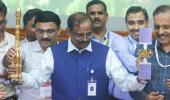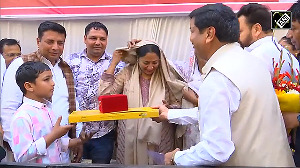'The work is already on with various data being studied.'

The Indian Space Research Organisation on Saturday said it has successfully carried out the ignition trial of the indigenous CE20 cryogenic engine powering the upper stage of LVM3 rocket under vacuum conditions.
According to ISRO on Friday it had conducted the ignition trial of the CE20 cryogenic engine with a multi-element igniter under vacuum conditions, which simulates the engine ignition in the vacuum condition of space.
This test was carried out at the High Altitude Test Facility at the ISRO Propulsion Complex, Mahendragiri, Tamil Nadu.
During this test, the ignition of the engine thrust chamber was carried out with a multi-element igniter in vacuum, under the tank pressure conditions that are expected to prevail at the time of restarting the cryogenic engine in flight.
The performance of the engine and the facility during the test was normal and as expected, ISRO said.
ISRO is exploring the initiation of turbo pumps in bootstrap mode rather than the stored gas system.
'In this approach, both the thrust chamber and gas generator are expected to re-ignite under tank head conditions. ISRO has outlined a series of tests aimed at engine starts in bootstrap mode towards enhancing the capability for multiple cryogenic engine restarts during flight,' the space agency said.
Previously, the engine ignition trial using a multi-element igniter was carried out under ground conditions outside the vacuum chamber.
The engine is already qualified to operate for thrust levels ranging from 19t to 22t in flight with single start and is qualified for India's human space flight mission Gaganyaan.
The engine was developed by ISRO's Liquid Propulsion Systems Centre.
Meanwhile, ISRO has formed a committee headed by former Chairman A S Kiran Kumar to look into the causes for the failure of the pyro valve in the country's latest navigation satellite NVS-02 orbited last month.
Confirming that he is heading the NVS-02 Failure Analysis Committee, Kumar told this correspondent: "The work is already on with various data being studied. No timeframe has been set for the submission of the report."
ISRO usuallt forms a Failure Analysis Committee to study the causes for the failure of a rocket/satellite and recommend measures to prevent such failures in the future.
The 2,250 kg NVS-02 costing about Rs 300 crore (Rs 3 billion) that was placed in the Geosynchronous Transfer Orbit (GTO) on January 29, 2025 is stuck there as its pyro valve did not open to pump in the oxidiser to fire the motors while the fuel pumps were working.
Only by firing the on-board liquid apogee motors, a satellite can be taken to its intended orbital slot. As per the original plan, the NVS-02 satellite was to be placed in a Geosynchronous Orbit over India so that it moves in line with earth's rotation.
It is reliably learnt ISRO is switching on the various systems in the satellite and found that they are working well. The commissioning process of the satellite is going on, a person in the know said not wanting to be quoted.
While NVS-02 will be in an elliptical orbit and not circular, ISRO said it will nevertheless use the same for navigation purposes.
The satellite can be used for navigation purposes whenever it is over India and if all the systems work well but with a shortened life span, it is learnt.
The NVS-02 was orbited by the Geostationary Satellite Launch Vehicle (GSLV) costing about Rs 300 crore, said a retired senior official of ISRO speaking on the condition of anonymity.
Interestingly, it was the 100th rocket launch at the Sriharikota spaceport.
"We will be raising the orbit using the thrusters with the available propellant. The satellite's condition is healthy," ISRO Chairman Dr V Narayanan told this reporter. "The satellite will be used for navigation purposes only."
When asked about the pyro valve failure Dr Narayanan reiterated that the satellite would be raised using the thrusters.
Venkatachari Jagannathan can be reached at venkatacharijagannathan@gmail.com











 © 2025
© 2025